
Lucena is a Spanish city and municipality, in the province of Córdoba, autonomous community of Andalusia, 60 km southeast of the provincial capital Córdoba. Its circa 42,000 people makes Lucena the second largest municipality in the province after Córdoba. It is located at the conjunction of important highways in the geographical center of Andalusia. People from Lucena are called lucentinos. The city was originally known as Eliossana, etymologically reinterpreted as deriving from the Hebrew אלי הושענא Elí hoshanna, "May God save us". The name in Arabic is اليسانة Al-Yussana.
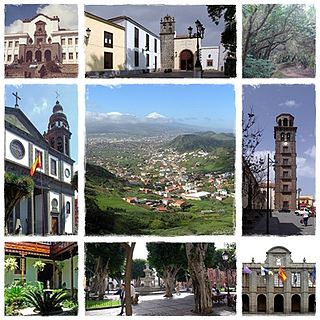
San Cristóbal de La Laguna is a city and municipality in the northern part of the island of Tenerife in the Province of Santa Cruz de Tenerife, on the Canary Islands, Spain. The city is the third-most populous city of the archipelago and the second-most populous city of the island. La Laguna's historical center was declared a World Heritage Site by UNESCO in 1999. In 2003 the municipality started an ambitious Urban Plan to renew this area, that was carried out by the firm AUC S.L.. The city was the ancient capital of the Canary Islands. La Laguna lies right alongside the city of Santa Cruz de Tenerife; thus, the two cities and municipalities form a single large urban center, linked by tram.

Tobarra is a municipality in the province of Albacete in Spain, with a population of c. 8,000 as of 2009.
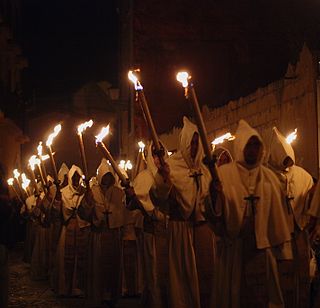
Holy Week in Zamora, Spain, is the annual commemoration of the Passion of Jesus Christ that takes place during the last week of Lent, the week immediately before Easter. Holy Week is the Christian week from Palm Sunday through Easter Sunday. It can take place in March or April. In Zamora, Holy Week is celebrated by 16 Catholic religious brotherhoods and fraternities that perform penance processions on the streets of the city.

Holy Week in Seville is one of two biggest annual festivals in Seville, Andalusia, Spain, the other being the Feria de Abril, which follows two weeks later. It is celebrated in the week leading up to Easter, and features the procession of pasos, floats of lifelike wooden sculptures of individual scenes of sorrowful Mysteries of the Rosary, or images of the grieving Virgin Mary.

Tenerife Tram is a light rail or tram service located on the island of Tenerife, one of the Canary Islands in Spain. It is operated by Metropolitano de Tenerife, a limited company now 100% owned by Cabildo de Tenerife. Service started on 2 June 2007 over a 12.5-kilometre (7.8 mi) route that linked the Intercambiador in Santa Cruz de Tenerife with Avenida de la Trinidad in La Laguna. A second line between La Cuesta and Tíncer opened in 2009. It is the only existing tramway or train in the Canary Islands.

The Diocese of San Cristóbal de La Laguna, also called Diocese of Tenerife or Diocese Nivariense, is a diocese located in the city of San Cristóbal de La Laguna in the Canary Islands and a suffragan in the ecclesiastical province of the Archdiocese of Sevilla in Spain. The diocese includes the islands of Tenerife, La Palma, La Gomera and El Hierro, in the province of Santa Cruz de Tenerife. The bishop of this diocese is Bernardo Álvarez Afonso.
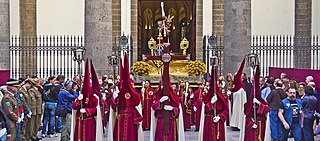
Holy Week in Spain is the annual tribute of the Passion of Jesus Christ celebrated by Catholic religious brotherhoods and fraternities that perform penance processions on the streets of almost every Spanish city and town during the last week of Lent, the week immediately before Easter.

The Basilica of the Royal Marian Shrine of Our Lady of Candelaria is a Roman Catholic minor basilica, the first Marian shrine of the Canary Islands, located in the municipality and city of Candelaria on the island of Tenerife. It is located some 20 km (12 mi) south of the island's capital, Santa Cruz de Tenerife.

The Cathedral of San Cristóbal de La Laguna or Catedral de Nuestra Señora de los Remedios is a Roman Catholic church in Tenerife, Spain. Begun in 1904 and completed in 1915, it is dedicated to the Virgin of Los Remedios. The cathedral is the mother church of the diocese, which includes the islands of Tenerife, La Palma, La Gomera and El Hierro in the province of Santa Cruz de Tenerife. It is therefore where the episcopal seat of the bishop of this diocese, currently occupied by Bishop Bernardo Álvarez Afonso. This is one of the most important churches of the Canary Islands.

The Cristo de La Laguna is a Catholic figure of great historical, artistic and cultural image that represents the crucified Jesus of Nazareth. Situated in the Real Santuario del Santísimo Cristo de La Laguna, in city of San Cristóbal de La Laguna.
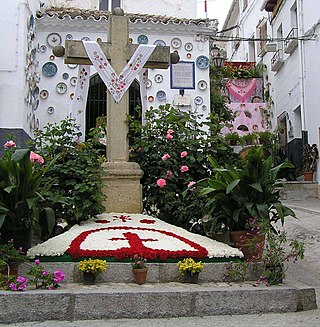
The Fiesta de las Cruces or Cruz de Mayo is a holiday celebrated on 3 May in many parts of Spain and Hispanic America.

The Plaza de la Patrona de Canarias is a large square in Candelaria, Tenerife. It is next to the Basilica of Candelaria, a meeting place of pilgrims and festivities celebrating the most important of the municipality. In this square there are also various bars and cafes.

The Señor de las Tribulaciones is the name given to an image of Jesus Christ that is venerated in the Iglesia de San Francisco de Asís in the city of Santa Cruz de Tenerife.

Holy Week in Mexico is an important religious observance as well as important vacation period. It is preceded by several observances such as Lent and Carnival, as well as an observance of a day dedicated to the Virgin of the Sorrows, as well as a Mass marking the abandonment of Jesus by the disciples. Holy Week proper begins on Palm Sunday, with the palms used on this day often woven into intricate designs. In many places processions, Masses and other observances can happen all week, but are most common on , Good Friday, Holy Saturday and Easter Sunday, with just about every community marking the crucifixion of Jesus in some way on Good Friday. Holy Saturday is marked by the Burning of Judas, especially in the center and south of the country, with Easter Sunday usually marked by a Mass as well as the ringing of church bells. Mexico's Holy Week traditions are mostly based on those from Spain, brought over with the Spanish conquest of the Aztec Empire, but observances have developed variations in different parts of the country due to the evangelization process in the colonial period and indigenous influences. Several locations have notable observances related to Holy Week including Iztapalapa in Mexico City, Taxco, San Miguel de Allende and San Luis Potosí.

Holy Week in Salamanca is the most important religious event of Salamanca, Spain. It is celebrated in the week leading up to Easter.
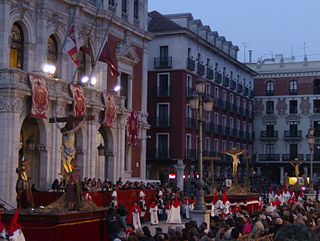
The Holy Week in Valladolid is one of the main tourist attractions, and cultural and religious events of Valladolid and the surrounding province during Holy Week in Spain. It boasts of renowned polychrome sculptures, created mainly by sculptors such as Juan de Juni and Gregorio Fernández, who were active when the city served as the imperial court. The city's National Sculpture Museum has a total of 42 images for the processions. The Holy Week in Valladolid is known to depict the Passion with great fidelity, rigor and detail.
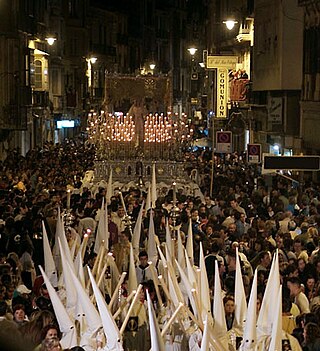
Holy Week in Málaga, is the annual commemoration of the Passion of Jesus in Málaga, Spain. It takes place during the last week of Lent, the week immediately before Easter. It is one of the city's main cultural and religious events.

Holy Week in San Cristóbal de La Laguna is a traditional event that has been repeated for centuries in the historic center of San Cristóbal de La Laguna, a city located on the island of Tenerife, Spain. It is considered the most remarkable Holy Week in the Canary Islands.



















